This is an up-to-date list of all my academic publications. Every article is available to download for free. Some are available under open licenses (such as Creative Commons), others are subject to restrictions by their corresponding publishing companies. Generally the PDF files provided here are “author copies” and the final formatted versions (sometimes called “version on record”) will be available directly from the publisher, in some cases for a fee. However, as far as I am aware there are no textual differences between the versions, so these copies should be suitable for citing.
Exploring body tracking sensors in longitudinal ambient display studies in the wild
i-com
November 2025
Body tracking sensors (i.e., depth cameras) such as Microsoft Kinect have been utilized in ambient display research for more than a decade. They facilitate a deeper understanding of phenomena occurring throughout interactions, aid the investigation of ambient displays within a broader context, and effectively complement existing qualitative methods such as on-site observations. Although these sensors have made significant contributions to research, there are still challenges with regard to data collection and analysis, particularly in light of recent advances in artificial intelligence. Further research is needed into how these sensors can contribute to a better understanding of how ambient displays are used in practice long term and how they can help to develop this understanding. In this article, we expand on the potentials and limitations of body tracking sensors that we experienced in our own in-the-wild research. To this end, we present insights from a small fleet of long-term, real-world installations of ambient displays we manage, which incorporate multiple body tracking sensors. The present article is concluded with a discussion of future directions for the field. In particular, the present study explores the potential contributions of body tracking sensors to recent methodological developments in the field of Human-Computer Interaction.
Examining Real-World Use of Collaboration Tools through Body Tracking Sensors
Mensch und Computer 2025 – Workshopband
August 2025
Body tracking sensors have become cheap and accessible enough for use as a component in semi-automated long-term deployment studies on how people use collaboration tools or other interactive technology in the field. In this position paper we briefly describe our experience administering a body tracking sensor setup for a small fleet of interactive ambient displays at a university, outline the benefits and drawbacks of using body tracking data to quantitatively examine how people interact with technology, and summarize the technical and methodological issues involved. We follow with a summary of our methodological framework for integrating qualitative ethnographic methods with this quantitative and sensor-based approach.
An Integrated Methodological Framework to Investigate Hybrid Work Technologies
2nd International Workshop on Hybrid Collaboration – EUSSET Conference on Computer-Supported Cooperative Work (ECSCW) 2025
June 2025
As hybrid work continues to gain prominence in the lives of people around the world, research struggles to grasp its deeper socio-technical implications. We have identified relevant gaps in the existing methodological landscape and outline early-stage design work on a framework that integrates qualitative ethnographic methods with quantitative, sensor-based data collection techniques. This framework will allow us to explore hybrid work technologies more holistically. Although it is still untested, the framework is based on our previous longitudinal research on ambient displays, which already leveraged a mixed methods approach. We hope that it will contribute to the ongoing methodological discussion within the HCI and CSCW communities, and ultimately result in more ambitious and, importantly, long-term research in this area.
ORCID and the Fediverse: What Can We Do with Public Information?
EUSSET Conference on Computer-Supported Cooperative Work (ECSCW) 2025
June 2025
ORCID is an identification scheme and bibliographic database for academics that aims to make information about researchers’ works widely and easily accessible. The Fediverse is a collection of interoperable social media platforms where people can follow each other across platform boundaries to read and share text posts or other media. Between these two environments, we observe contrasting social norms around “public data” and conflicting expectations on how personal information may be stored and republished. During the early design phase of a tool to bridge ORCID data into the Fediverse and make individual ORCID records followable on open social platforms, we face a need to connect and resolve these differences to prevent avoidable conflicts. This article documents these norms and expectations as well as our approach to connect and bridge them.
Untersuchung des Honeypot-Effekts an (halb-)öffentlichen Ambient Displays in Langzeitfeldstudien
Universität der Bundeswehr München, Hochschule für Angewandte Wissenschaften Hamburg
November 2024
Im Rahmen des Projektes ist ein Framework zur Analyse der Nutzung von interaktiven großen Wandbildschirmen im Feldeinsatz entstanden – von Erfahrungsberichten bei Konzeption und Aufbau bis zu Open Source Toolsets. Diese erlauben eine parallele Analyse von Interaktions- und Beobachtungsdaten und schaffen neue Möglichkeiten, die Nutzung von im Langzeitbetrieb befindlichen Wandbildschirmen teilautomatisiert zu untersuchen und dabei umfangreiche sensorbasierte Datensätze hinsichtlich interessanter Muster zu filtern und zu visualisieren. Der Einsatz dieses Frameworks im Bereich Honeypot- und Novelty-Effekt zeigt, dass durch eigene Entwicklung von Methoden und Werkzeugen zur Analyse von Body-Tracking-Daten die Identifikation von möglichen Situationen zur genaueren Untersuchung viel einfacher geworden ist. Auch sind quantitative Abschätzungen dazu möglich, wie häufig Honeypot- und andere Effekte auftreten und wie deren Häufigkeit sich über Monate und Jahre wandelt.
Herausforderungen menschengerechter Forschung mit Body-Tracking-Sensoren in Langzeit-Feldstudien
Mensch und Computer 2024 – Workshopband
August 2024
In der Mensch-Computer-Interaktion sind Beobachtungsstudien ein bewährtes Mittel, um Erkenntnisse darüber zu gewinnen, wie Menschen sich in der Interaktion mit digitalen Systemen verhalten. Um solche Beobachtungen über längere Zeiträume durchführen und reichhaltigere Beobachtungsdaten sammeln zu können, werden mitunter optische Sensoren eingesetzt, die bestimmte Aspekte des Verhaltens ohne kontinuierliche menschliche Betreuung aufzeichnen können. Wie können solche Sensoren menschenwürdig und unter Wahrung der Privatsphäre eingesetzt werden und welche Fallstricke sind dabei zu beachten? Wir berichten aus dem Projekt Untersuchung des Honeypot-Efekts an (halb-)öfentlichen interaktiven Ambient Displays in Langzeitfeldstudien und refektieren in diesem Beitrag Aspekte der Inklusion und des respektvollen Umgangs mit Versuchspersonen.
Reflecting on a Smart City Project for Older Adults
Mensch und Computer 2024 – Workshopband
August 2024
Between 2015 and 2020 we participated in a joint research project to explore technological interventions fostering participation of older adults in urban spaces. UrbanLife+ involved multi-year qualitative and quantitative empirical work on obstacles faced by people aged 65 and up living in cities. This brief retrospective does not recap the previously published results of the project, but summarizes methodological and organizational insights as well as pragmatic experiences gathered during its runtime that have not yet been discussed publicly. We focus on aspects relevant for future urban technology projects aiming for accessibility and inclusivity. These include issues navigating interdisciplinary design teams, conducting questionnaire studies with older adults, maintaining participatory design principles with geographically distributed teams, and conducting empirical evaluations during the COVID-19 pandemic.
A New Software Toolset for Recording and Viewing Body Tracking Data
Mensch und Computer 2023 – Workshopband
August 2023
While 3D body tracking data has been used in empirical HCI studies for many years now, the tools to interact with it tend to be either vendor-specific proprietary monoliths or single-use tools built for one specific experiment and then discarded. In this paper, we present our new toolset for cross-vendor body tracking data recording, storing, and visualization/playback. Our goal is to evolve it into an open data format along with software tools capable of producing and consuming body tracking recordings in said new format, and we hope to find interested collaborators for this endeavour.
Setting up a long-term evaluation environment for interactive semi-public information displays
Mensch und Computer 2023 – Workshopband
August 2023
Human-computer interaction research increasingly focuses on the long-term evaluation of real-world field deployments. When dealing with innovative solutions and when asking for the possibility to do action research in the deployment, fitting real-world deployments are hard to find – and access to these deployments is hard to obtain. We decided to invest in setting up and managing a long-term deployment of an interactive large information screen solution at our university, which includes several displays. In this paper, we briefly report about the installation – the CommunityMirror Network – as well as its functionality and operations management.
Methods and Tools for (Semi-)Automated Evaluation in Long-Term In-the-Wild Deployment Studies
Mensch und Computer 2023 – Workshopband
August 2023
Human-computer interaction increasingly focuses on long-term evaluation of in-the-wild deployments. With this trend, however, understanding the usage behavior becomes more challenging. Due to the high repeating manual labor involved, existing methods such as in-situ observations and manual video analysis are no promising prospects on this avenue. Automated approaches (e.g., based on body tracking cameras) have been suggested recently to capture the usage behavior in long-term evaluations more efficiently. Still, these approaches may not be the only ones under consideration to move the field forward from here. This workshop gathers and reflects on the current state of the art regarding this trend and outlines perspectives for future research. The contributions cover, among other topics: methods and tools for data collection, noise and errors in sensor data, the correlation of automated observations with ground truth data, and augmenting sensor data with field work (e.g., interviews) for the contextualization of findings.
Exploring Mobility Behavior Around Ambient Displays Using Clusters of Multi-dimensional Walking Trajectories
Extended Abstracts of the 2023 CHI Conference on Human Factors in Computing Systems
April 2023
Spatial information has become crucial in ambient display research and helps to better understand how people behave in a display’s vicinity. Walking trajectories have long been used to uncover such information and tools have been developed to capture them anonymously and automatically. However, more research is needed on the level of automation during mobility behavior analyses. Particularly, working with depth-based skeletal data still requires signifcant manual efort to, for instance, determine walking trajectories similar in shape. To advance on this situation, we adopt both agglomerative hierarchical clustering and dynamic time warping in this research. To the best of our knowledge, both algorithms have so far not found application in our feld. Using a multi-dimensional data set obtained from a longitudinal, real-world deployment, we demonstrate here the applicability and usefulness of this approach. In doing so, we contribute insightful ideas for future discussions on the methodological development in ambient display research.
ACM Copyright Notice: © 2023 Copyright held by the owner/author(s). Publication rights licensed to ACM. This is the author’s version of the work. It is posted here for your personal use. Not for redistribution. The definitive Version of Record was published in Extended Abstracts of the 2023 CHI Conference on Human Factors in Computing Systems (CHI EA ’23), April 23–28, 2023, Hamburg, Germany, https://doi.org/10.1145/3544549.3585661.
Gestaltung von Quests in vernetzten Informationsstrahlern im urbanen Raum zur Steigerung der Teilhabe älterer Menschen
Dissertation, Universität der Bundeswehr München
Februar 2023
Vernetzte interaktive Geräte (z. B. Wandbildschirme, digitale Hinweisgeber) gewinnen im öffentlichen Raum an Präsenz. Sie bieten große Potenziale für personalisierte Nutzungserfahrungen. In dieser Arbeit geht es um Erkenntnisse dazu, wie die Interaktion mit solchen Geräten gestaltet sein sollte, um unter besonderer Berücksichtigung der Nutzbarkeit durch ältere Menschen ein spielerisches Erkunden des urbanen Raums zu ermöglichen und zu fördern. Dazu werden bestehende Ideen zu Joy of Use und Gamification aufgegriffen und insbesondere das Spielelement der „Quest“ auf seine Eignung zur Strukturierung und Motivation von Erlebnisangeboten außerhalb der eigenen vier Wände überprüft. Ein System zur Aktivitätsunterstützung älterer Menschen im städtischen Raum wird entworfen und prototypisch umgesetzt. Anhand von Nutzertests und Befragungen der Zielgruppe wird es qualitativ evaluiert. Die Ergebnisse zeigen, dass ein solches System bei der Zielgruppe Anklang finden kann. Die Evaluationsdaten werden durch agentenbasierte Simulationen von flächendeckenden Deployments weiter angereichert, um Aussagen zu den Voraussetzungen für flächendeckende Einsätze treffen zu können. Aus den so gewonnenen Erkenntnissen werden insgesamt neun Gestaltungsempfehlungen für vergleichbare Systeme entwickelt und präsentiert.
MTI: Interaktion und Personalisierung mit Smarten Städtebaulichen Objekten
In diesem Kapitel wird auf Mensch-Technik-Interaktion (MTI) mit Smarten Städtebaulichen Objekten (SSO) zur Verbesserung der Safety älterer Menschen eingegangen. Insbesondere werden Herausforderungen und Gestaltungsempfehlungen für solche SSO vorgestellt (Anpassungsfähigkeit, Mehrbenutzerfähigkeit, Walk-Up-And-Use-Fähigkeit und Joy-of-Use) und anhand der im Projekt UrbanLife+ entwickelten SSO präsentiert.
Stadt der Zukunft – Smartes Stadtmobiliar für mehr Teilhabe im Alter
Dezember 2021
Im Fokus steht eine von den Autoren entwickelte städtebauliche Vision städtischer Quartiere, die älteren Menschen im urbanen Raum größtmögliche Sicherheit vermittelt und diese durch digitale Transformation des Stadtmobiliars in Form einfacher, praktischer Handreichungen ganz konkret zur Verfügung stellt.
Ausgehend von einer umfassenden Bedarfsanalyse in Mönchengladbach führen die Autoren Schritt für Schritt durch die Konzeption, Planung, technische Umsetzung und Erprobung. Dabei steht immer das umfassend definierte städtebauliche Ziel der „Safety“ urbaner Räume mit jeweils spezifischer Ausrichtung auf den Bedarf von Personen mit altersbedingten Einschränkungen im Mittelpunkt. Ergänzend zu den Beiträgen werden dem Stadtplaner weitere Lösungsansätze für diese digitale Transformation urbaner Räume zur Verfügung gestellt.
How Content Drives Interaction With Public Displays
Interactive Surfaces and Spaces (ISS '21 Companion)
November 2021
Existing research into user engagement with public displays tends to focus on aspects of visual and interaction design, with less thought given towards how the choice of content may influence user behavior. In this article, we survey the existing literature, particularly deployment studies of public displays, for lessons learned on the ramifications of content with different properties. We find that local and timely relevance of content, as well as user-driven content creation, have been independently shown to foster user engagement, but that few other solid conclusions can be drawn from the literature. On the whole, the aspect of content tends to be underspecified and not fully reflected in studies of public displays.
ACM Copyright Notice: © 2021 Copyright held by the owner/author(s). Publication rights licensed to ACM. This is the author’s version of the work. It is posted here for your personal use. Not for redistribution. The definitive Version of Record was published in Interactive Surfaces and Spaces (ISS ’21 Companion), November 14–17, 2021, Lodz, Poland, https://doi.org/10.1145/3447932.3490525.
Activity Support for Seniors Using Public Displays: A Proof of Concept
Mensch und Computer 2021 – Tagungsband
September 2021
Seniors face many challenges in their daily activities regarding mobility and accessibility. We have designed and prototyped a system of networked public displays to support them, particularly regarding outdoor pedestrian navigation. This article describes the process and results of a qualitative evaluation of this prototype system, which was conducted with seven participants, a mixture of older adults and experts on geriatric care. Based on insights gained from these interviews, we provide guidance on the design of outdoor activity support systems for seniors.
Designing Smart Urban Objects – Adaptation, Multi-user Usage, Walk-up-and-use and Joy of Use
Schriften zur soziotechnischen Integration, Volume 8
February 2021
Designing human-computer interaction for non-personal computing devices in urban space poses different challenges than designing for personal devices. In this paper we summarize the findings from a project developing smart urban objects to help elderly people participate in urban life. We present four key challenges that have been identified designing such objects, and present first ideas for how to address these challenges. The four key challenges are adaptability (and data privacy), multi-user usage, walk-up-and-use and joy of use.
Verbundprojekt UrbanLife+: Teilhabe am städtischen Leben Mönchengladbachs durch MTI mit smarten städtebaulichen Objekten – Schlussbericht Universität der Bundeswehr München
Mensch-Technik-Interaktion mit smarten städtebaulichen Objekten: Entwicklung und Evaluation
Schriften zur soziotechnischen Integration, Band 7
Dezember 2020
Die Selbstbestimmung älterer Menschen wird wesentlich davon bestimmt, sich sicher in ihrer jeweiligen Umgebung bewegen zu können. Nachlassende Fähigkeiten zur Interaktion mit der Umgebung schränken die soziale und kulturelle Teilhabe Älterer jedoch ein bis hin zur sozialen Isolation. Hier eröffnen Methoden der Mensch-Technik-Interaktion (MTI) vielfältige neue Möglichkeiten, altersbedingte Einschränkungen auszugleichen. Dieser Bericht beschreibt die Ergebnisse des Verbundvorhabens UrbanLife+, dessen Zielsetzung es war, die Potenziale von MTI-Innovationen in einem übergeordneten Safety-Konzept zu identifizieren, zu integrieren, ihre Wirk-samkeit und Nützlichkeit besser zu verstehen und praktische Erfahrungen in der Stadt Mönchengladbach zu sammeln. Aus einer Anforderungsanalyse wurden neben Personas und konkreten Szenarien verschiedene Konzepte für smarte städtebauliche Objekte (SSO) entwickelt und einige davon in Prototypen umgesetzt. Insbesondere wurden von der Universität der Bundeswehr (UBW) smarte interaktive Informationsdisplays und Mikro-Informationsstrahler mit einem vernetzenden Aktivitätsunterstützungsdienst in mehreren Iterationen umgesetzt und evaluiert. Bei der Evaluation wurden dabei neue Konzepte für die Evaluation im urbanen Raum entwickelt und teilweise erprobt. Ergebnisse des (Teil-)Projektes sind neben den Prototypen insbesondere eine Reihe von Gestaltungsempfehlungen für SSO.
Compatibility of Support and Autonomy in Personalized HCI
Schriften zur soziotechnischen Integration, Volume 6
November 2020
Developers and designers of interactive digital systems are faced with many challenges, some less visible than others. One of these more subtle balancing acts is between personalized user support and unrestricted user autonomy. It raises the question how a supportive design that takes a user’s needs and preferences into account can be implemented within a technical system while at the same time allowing the user to make decisions freely without restrictions. How can autonomy by design be incorporated into the process? In this paper we describe the breadth of choice heuristic, which can show where the support of the user by the system stops and a restriction of the user’s autonomy begins. To this end, we reference existing literature on similar issues, develop our own conclusions and apply them to our work in a project on IT for elderly people.
Design Guidelines for Micro Information Radiators to increase Seniors’ Safety in Urban Space
Mensch und Computer 2020 – Tagungsband
September 2020
Senior citizens face challenges during activities in urban space. To help and motivate them pursuing outside activities, we propose a network of (micro and macro) information radiators to increase their feeling of safety. In this paper we first collect guidelines and relevant aspects for the design of micro information radiators. Then we summarize our own experiences from a project designing smart urban objects – particularly giving an overview of design guidelines for input and output interaction of micro information radiators.
ACM Copyright Notice: © Association for Computing Machinery 2020. This is the author’s version of the work. It is posted here for your personal use. Not for redistribution. The definitive Version of Record was published in Proceedings of Mensch und Computer 2020, https://doi.org/10.1145/3404983.3410001.
A system design to support outside activities of older adults using smart urban objects
European Conference on Computer-Supported Cooperative Work (ECSCW) 2020
June 2020
During outside activities, elderly people encounter different challenges than young people. Those difficulties impede their motivation to pursue outside activities. To counter this problem from a human-computer interaction perspective, we propose a support system for seniors to improve their motivation and subjective safety while undertaking outside activities by coordinating smart urban objects. Drawing from an extensive empirical requirements analysis, we identify typical barriers experienced by seniors for which networked smart urban objects may provide assistance. We discuss a conceptual description of an activity support system: the system aggregates user profile data with information about the urban space to suggest possible activities, the elderly user chooses an activity and receives navigational assistance to increase their motivation and feeling of safety while undertaking the chosen activity. Finally, we discuss our approach regarding challenges such as user autonomy, privacy and real-world deployments, which need to be considered in future implementation and evaluation phases of the system.
Smart Urban Design Space
Proceedings of the 2019 Federated Conference on Computer Science and Information Systems
September 2019
The irreversible process of demographic change, especially in Germany, leads to numerous challenges. According to this, research has to face the task to integrate the constantly ageing population into the urban and public space in such a way that there are as few barriers as possible. With the support of digitalization, so-called smart urban objects are being designed in order to do make integration, so that people and the available technology can be used most efficiently. A special ontology has been developed to meet this demand.
Using hash visualization for real-time user-governed password validation
Mensch und Computer 2019 – Workshopband
September 2019
Building upon work by Perrig & Song, we propose a novel hash visualization algorithm and examine its usefulness for user-governed password validation in real time. In contrast to network-based password authentication and the best practices for security which have been developed with that paradigm in mind, we are concerned with use cases that require user-governed password validation in nonnetworked untrusted contexts, i.e. to allow a user to verify that they have typed their password correctly without ever storing a record of the correct password between sessions (not even a hash). To that end, we showcase a newly designed hash visualization algorithm named MosaicVisualHash and describe how hash visualization algorithms can be used to perform user-governed password validation. We also provide a set of design recommendations for systems where hash visualization for password validation is performed in real time, i.e. as the user is in the process of typing their password.
Quests als Gestaltungsmittel zur Motivation und Struktur außerhäuslicher Aktivitäten für Senioren
Mensch und Computer 2019 – Workshopband
September 2019
Im Rahmen des Verbundprojektes UrbanLife+ verfolgen wir einen Gamification-Ansatz, nach dem das spielerische Gestaltungsmittel der Quest als Grundlage dafür verwendet wird, Senioren zur Teilhabe an ihrem urbanen Umfeld zu motivieren, indem ihnen konkrete Vorschläge für Aktivitäten gemacht werden, welche mit einem Belohnungssystem verbunden sind. Das Gesamtsystem befindet sich derzeit noch in der Entwurfsphase. Eine Analyse der Anforderungen der Zielgruppe einschließlich einer umfassenden Befragung ist im Rahmen des Gesamtprojekts erfolgt. Dieser Beitrag beschreibt den aktuellen Planungsstand des Gamification-Systems sowie die dafür unmittelbar relevanten sonstigen Projektergebnisse und diskutiert die Herangehensweise.
The case for including senior citizens in the playable city
Proceedings of the International Conference on Web Intelligence 2017
August 2017
The topic of “playable cities” has recently emerged as a variation on smart cities, focusing on ways to make urban spaces more playfully interactive and fun by incorporating digital technology. Existing work in this field has largely focused on explorative design and case studies. As of yet, there are barely any design guidelines specific to the context. In this paper, we motivate the need for urban interaction designers to consider the restrictions of senior citizens, give a broad overview over interaction design recommendations for older adults as relevant for urban spaces, examine selected published “playable city” case studies for their suitability regarding this population group, and propose some preliminary design guidelines for future work.
ACM Copyright Notice: © Julian Fietkau 2017. This is the author’s version of the work. It is posted here for your personal use. Not for redistribution. The definitive Version of Record was published in Proceedings of the International Conference on Web Intelligence 2017, https://doi.org/10.1145/3106426.3109042.
Information Radiators – Using large screens and small devices to support awareness in urban space
Proceedings of the International Conference on Web Intelligence 2017
August 2017
Information radiators are ubiquitous stationary installations that radiate information that is likely to improve awareness of passers-by in semi-public environments like organization floors. In this paper, we present the idea of using several kinds of information radiators for enhancing urban participation of seniors - by providing awareness for supporting the planning and execution of activities in public environments. We motivate the idea and discuss interaction design as well as HCI challenges to be addressed in future work.
ACM Copyright Notice: © Michael Koch, Anna Kötteritzsch, Julian Fietkau 2017. This is the author’s version of the work. It is posted here for your personal use. Not for redistribution. The definitive Version of Record was published in Proceedings of the International Conference on Web Intelligence 2017, https://doi.org/10.1145/3106426.3109039.
Blurring Boundaries between Everyday Life and Pervasive Gaming – An Interview Study of Ingress
Proceedings of the 15th International Conference on Mobile and Ubiquitous Multimedia – MUM '16
December 2016
We present findings from an interview-based study of the pervasive mobile multiplayer game Ingress. Our study focuses on how boundaries between (1) everyday life and play and (2) 'real' and game space blur in pervasive gaming. We present findings on how the game is integrated into everyday life and affects players' mobility patterns, and on how players experience the relation between real world and game world, the game 'bleeding' into the everyday (blurring boundaries at least partially) even though it is not explicitly experienced as hybrid. Furthermore we discuss how notions of play versus ordinary life still affect some players, and how some players are willing to take and create risks and treat the game as consequential in their everyday interactions with (enemy) players. This further blurs the boundaries of the magic circle, but also creates tensions between casual and serious styles of play. Our findings add to the empirical literature on pervasive games by focusing on player experience in a large-scale pervasive game.
ACM Copyright Notice: © Pavel Karpashevich, Eva Hornecker, Nana Kesewaa Dankwa, Mohamed Hanafy, Julian Fietkau 2016. This is the author’s version of the work. It is posted here for your personal use. Not for redistribution. The definitive Version of Record was published in Proceedings of the 15th International Conference on Mobile and Ubiquitous Multimedia – MUM '16, https://doi.org/10.1145/3012709.3012716.
Connecting Interaction with Smart Urban Objects for Individual Support in Neighborhood Participation
Proceedings of the 6th International Conference on the Internet of Things – IoT'16
November 2016
Changing life in urban areas creates challenges for people who move and also for long-term inhabitants, who have to orientate themselves in new or changing environments. ICT has the potential to support people in orientating in urban neighborhoods as well as to foster participation when it comes to shaping future life in cities. We present results from a workshop on ICT in urban areas, which show the potential to connect interactive objects in public environments and to draw from community knowledge in order to support individual people in exploring their neighborhoods. In a use case we show how orientation help can be created in accordance to each person's comfort zone within the neighborhood. We conclude discussing further challenges in HCI research with focus on urban areas.
ACM Copyright Notice: © Anna Kötteritzsch, Julian Fietkau, Katrin Paldan, Michael Koch 2016. This is the author’s version of the work. It is posted here for your personal use. Not for redistribution. The definitive Version of Record was published in Proceedings of the 6th International Conference on the Internet of Things – IoT'16, https://doi.org/10.1145/2991561.2998475.
Workshopband Urban und Digital – Gemeinsam auf interaktiven Wegen
Smarte Städtebauliche Objekte zur Erhöhung der Teilhabe von Senioren
Mensch und Computer 2016 – Workshopband
September 2016
Der urbane Raum wird zunehmend intelligenter. So können Passanten mit Druckknöpfen an Ampelanlagen spielen, um die Rotphase zu überbrücken, Informationstafeln an Bushaltestellen zeigen Verspätungen des Busses an und WLAN-Technologie erlaubt das Erfassen der Bewegung unterschiedlicher Akteure im Raum. Die Vorteile aus dieser Vernetzung, stehen jedoch älteren Personen mit kognitiven oder motorischen Einschränkungen nicht offen. Technologien in der öffentlichen Umgebung beziehen Anforderungen älterer Personen bislang nicht ein. Ältere Personen werden durch die sich rapide ändernden sozialen und technologischen Strukturen von der Teilhabe ausgegrenzt. Wir stellen unseren Ansatz Smarter Städtebaulicher Objekte vor: Gegenstände aus der städtischen Umgebung, welche mit einem digitalen Informationsraum verbunden sind. Darunter fallen u. a. Parkbänke, die jüngere Personen durch Vibration darauf auf ältere Personen mit Bedarf an Sitzplätzen hinweisen, sowie Informationstafeln, die die Aktivitäten in der Nachbarschaft nutzergerecht aufbereiten. Anhand dessen wollen wir zeigen, wie das Gewahrsein im öffentlichen Raum auf die Belange älterer Personen erhöht werden kann.
Rapid Prototyping von Interaktionskonzepten in der universitären MCI-Lehre
Fachtagung zur Hochschuldidaktik der Informatik (HDI) 2014
September 2014
In der Lehre zur MCI (Mensch-Computer-Interaktion) stellt sich immer wieder die Herausforderung, praktische Übungen mit spannenden Ergebnissen durchzuführen, die sich dennoch nicht in technischen Details verlieren sondern MCI-fokussiert bleiben. Im Lehrmodul „Interaktionsdesign“ an der Universität Hamburg werden von Studierenden innerhalb von drei Wochen prototypische Interaktionskonzepte für das Spiel Neverball entworfen und praktisch umgesetzt. Anders als in den meisten Grundlagenkursen zur MCI werden hier nicht Mock-Ups, sondern lauffähige Software entwickelt. Um dies innerhalb der Projektzeit zu ermöglichen, wurde Neverball um eine TCP-basierte Schnittstelle erweitert. So entfällt die aufwändige Einarbeitung in den Quellcode des Spiels und die Studierenden können sich auf ihre Interaktionsprototypen konzentrieren. Wir beschreiben die Erfahrungen aus der mehrmaligen Durchführung des Projektes und erläutern unser Vorgehen bei der Umsetzung. Die Ergebnisse sollen Lehrende im Bereich MCI unterstützen, ähnliche praxisorientierte Übungen mit Ergebnissen „zum Anfassen“ zu gestalten.
Zum Anwendungspotential von Gamification in Unternehmen
Mensch und Computer 2014 – Workshopband
September 2014
Gamification, der Einsatz von Spielmechaniken in spielfremdem Kontext, ist ein Trend, der bei Unternehmen Beachtung findet und Interesse weckt Aspekte davon unternehmensintern einzusetzen. Demgegenüber besteht jedoch auch Skepsis, da ein spielerischer Ansatz im Bezug auf Geschäftsszenarien bisher unüblich ist und dessen langfristiger Erfolg bislang nicht belegt werden konnte. Ziel des Beitrags ist es, diesen Trend auf seine Möglichkeiten und besonderen Herausforderungen hin zu untersuchen. Dazu werden die einsetzbaren Spielmechaniken und ihre Wirkungen in Bezug zu relevanten Konzepten aus der Motivations- und Sozialpsychologie gesetzt. Daraus werden Empfehlungen für den Einsatz von Gamification im Kontext von unternehmensinternen Plattformen abgeleitet.
Entwicklung einer Software zum Interpretieren von Zeugnisnoten für Oberstufenschüler
Bachelorarbeit, Universität Hamburg
Januar 2014
Gegen Ende der Schullaufbahn stellt sich bei vielen Schülern verstärkt das Bewusstsein ein, dass die Zeugnisnoten (insbesondere der Abiturschnitt) einen starken Einfluss auf ihre Karrieremöglichkeiten haben. Die Gesetze und Regeln, nach denen die Punktzahlen miteinander verrechnet werden, sind jedoch komplex und für viele Schüler undurchsichtig. Insbesondere ist es schwierig, bei einem noch nicht abgeschlossenen Abitur die bereits vorhandenen Noten zu interpretieren und mögliche Probleme frühzeitig zu erkennen. Im Rahmen dieser Bachelorarbeit wird zur Unterstützung der Beratung an einer ausgewählten Schule ein System umgesetzt, das den Schülern bei dieser Aufgabe unter die Arme greift. Aus partiell vorliegenden Noten werden möglichst viele relevante Informationen gewonnen, aufbereitet und den Schülern dargestellt. Für diese Aufgabe findet ein Entwicklungsprozess gemäß User Centered Design statt.
Das Teachlet-Konzept: Möglichkeiten und Grenzen einer Lehrform für Software-Entwurfsdiskussionen
Bachelorarbeit, Universität Hamburg
Dezember 2010
Teachlets als innovative Lehrmethode befinden sich seit 2004 im Praxiseinsatz, Literatur ist zum Thema allerdings kaum vorhanden und nicht auf dem aktuellen Stand. In dieser Arbeit wird die Teachlet-Praxis der letzten Jahre resümiert, die bisherige Definition des Begriffs auf ihre Zukunftsfähigkeit untersucht und erweitert, aktuelle Entwicklungen dargestellt und konzeptuelle Grenzen sowie weitere Möglichkeiten von Teachlets als Lehrform für Inhalte der Softwaretechnik diskutiert.
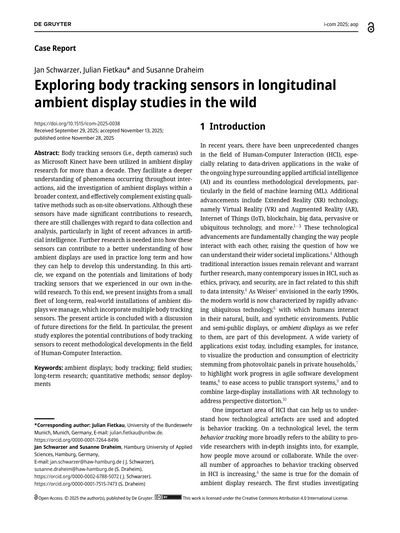







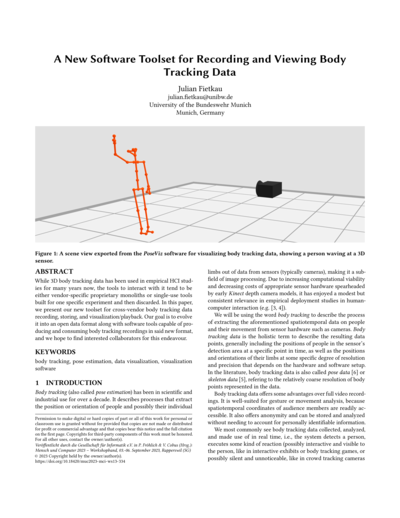
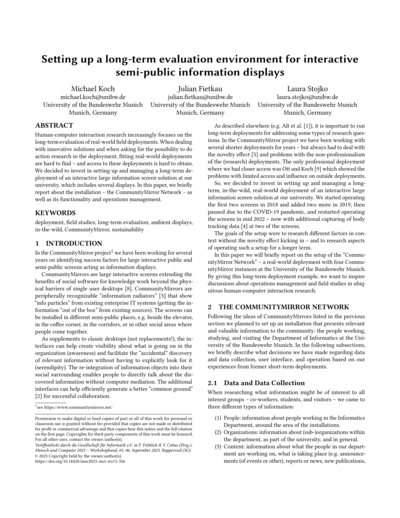

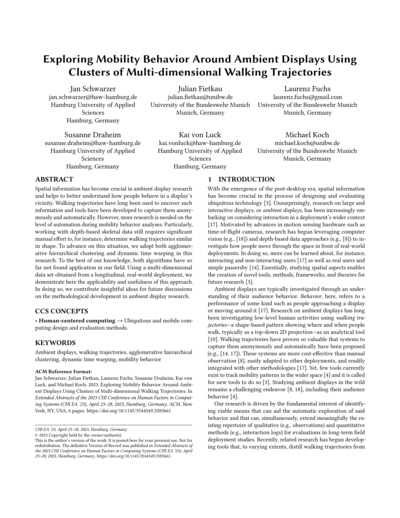
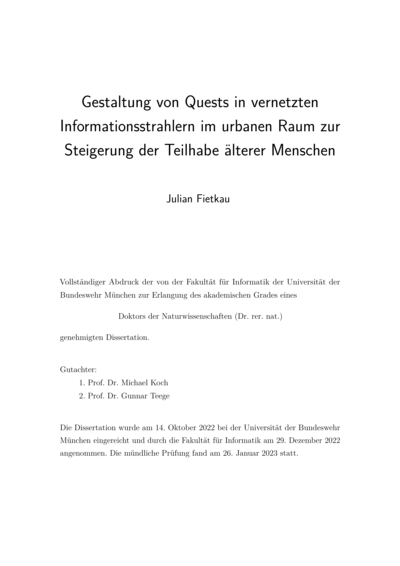
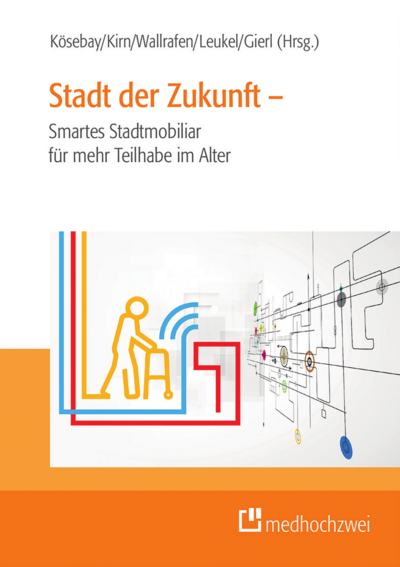

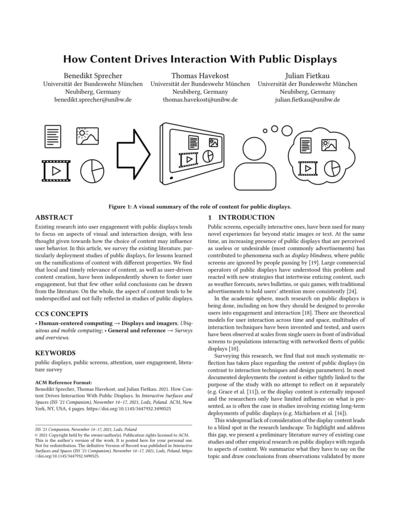
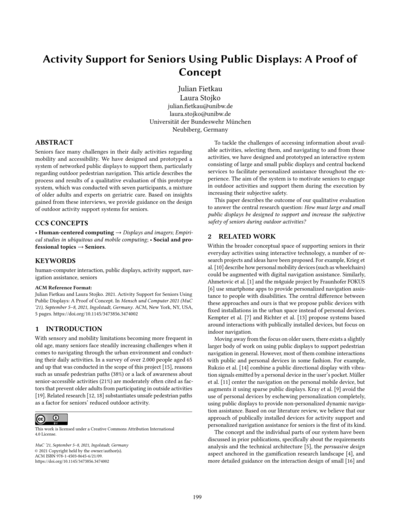
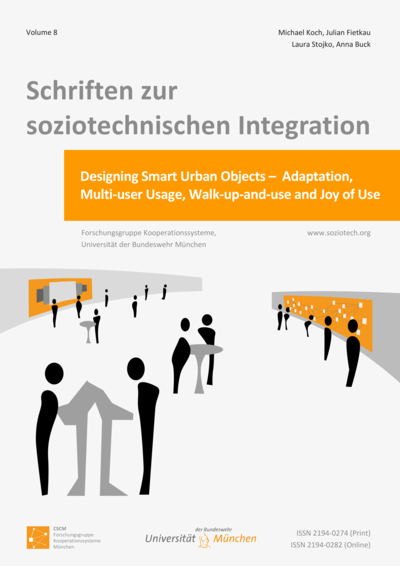
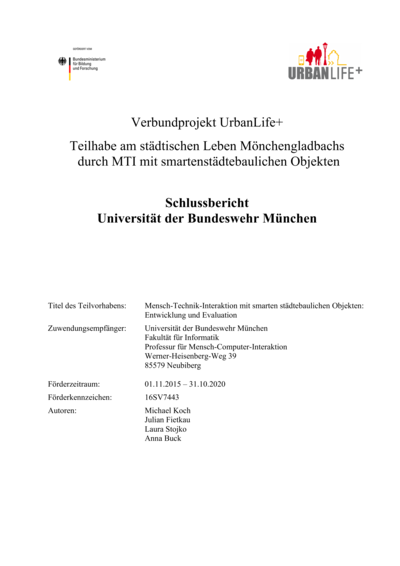
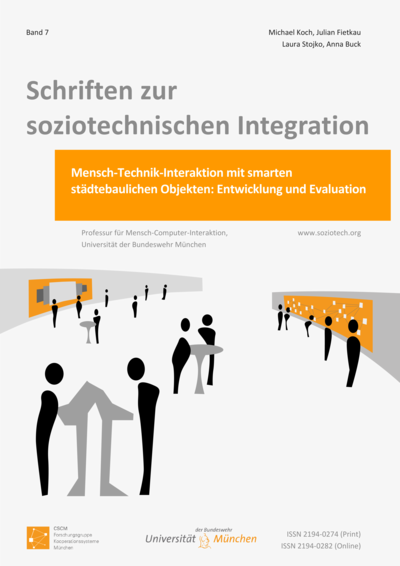

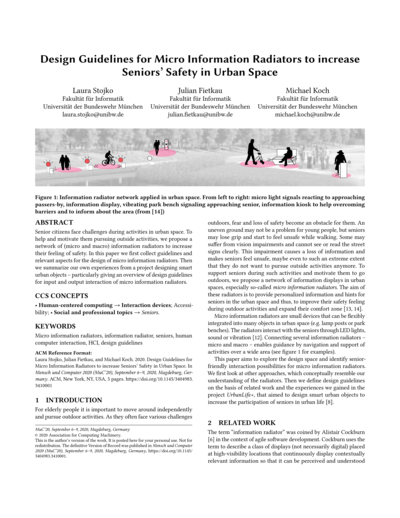
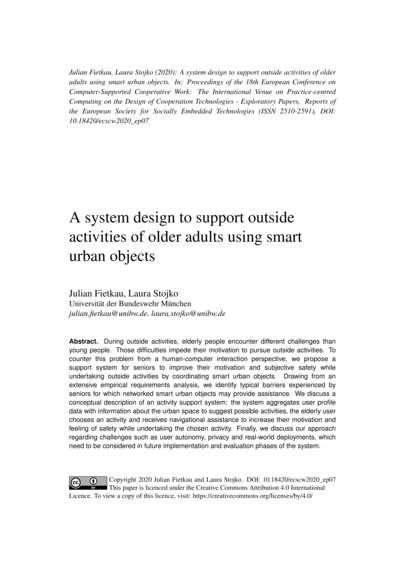
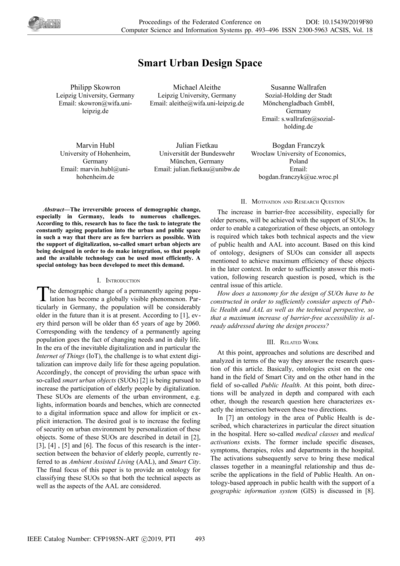
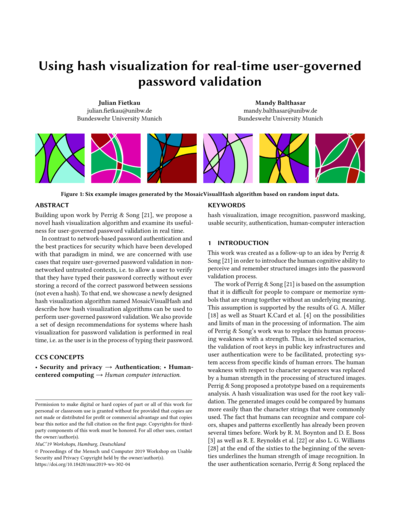
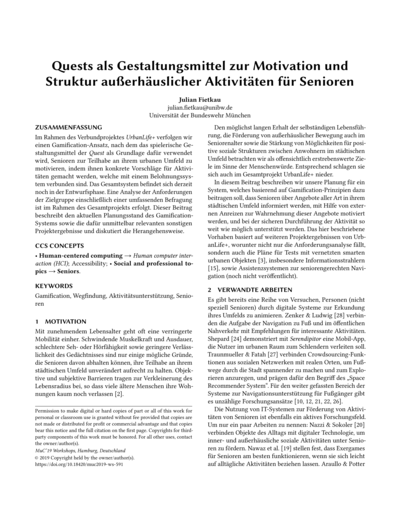
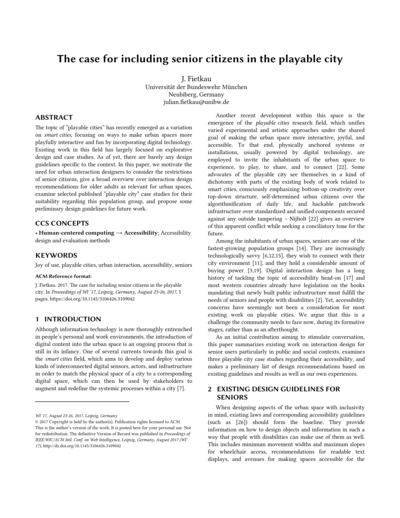
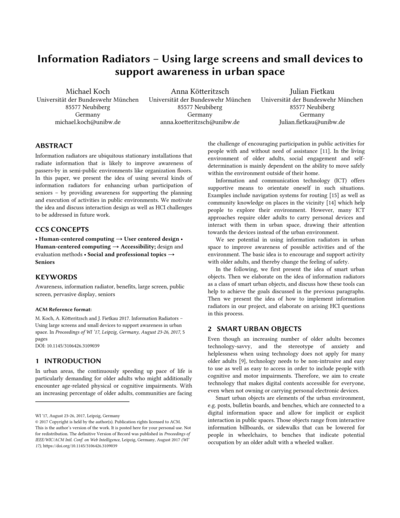
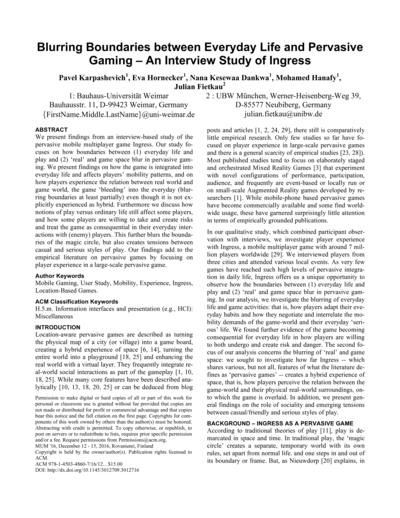
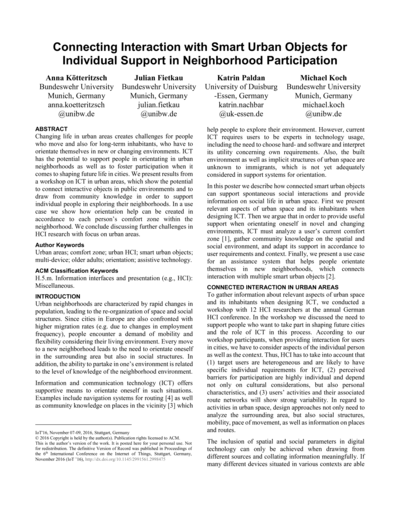
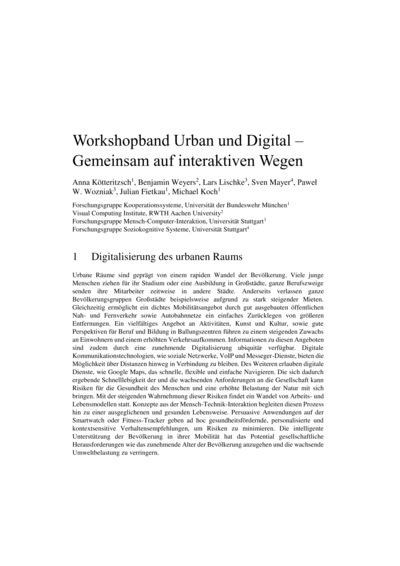
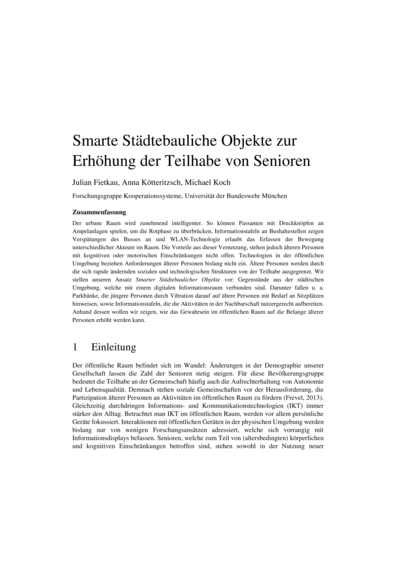
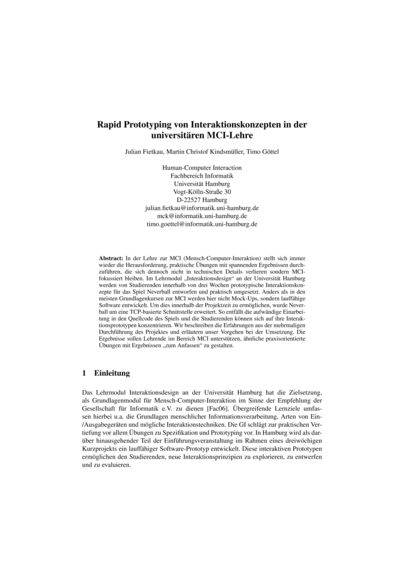
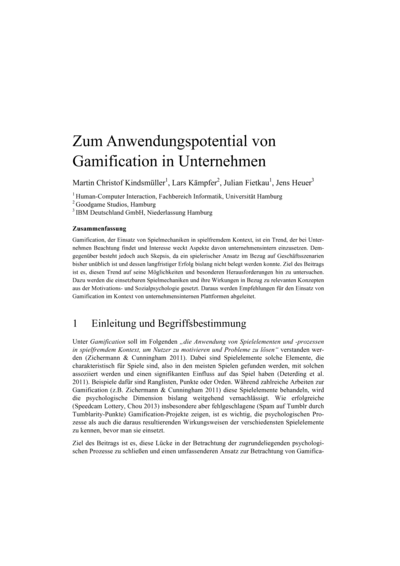
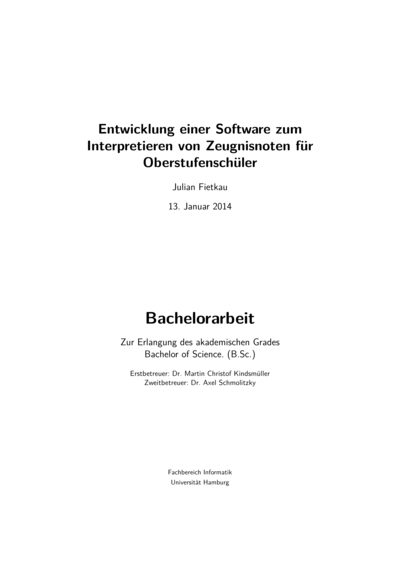

Impacting the social presence of virtual agents by scaling the fidelity of their speech and movement
Julian Fietkau (ORCID record: https://orcid.org/0000-0001-7264-8496)
Master thesis, Universität Hamburg
February 2015
Virtual agents are constructs that fulfill human or human-like roles in virtual environments, but are directly controlled by software instead of real humans. They have use cases such as presenting information, demonstrating actions or simulating a social environment. If a real person perceives them as sufficiently human-like, they may induce social phenomena like empathy, competition or conversational turn taking, even if the person is consciously aware that the agent is purely virtual. This thesis explores the influence of technical fidelity on perceived social presence in terms of the virtual agents’ speech and movement. Both of these two variables were assigned different implementations of varying technical sophistication, from text-to-speech output to fully recorded voices and from a completely rigid idle body to a high-quality relaxed idle animation based on motion capturing data. The various combinations were tested in an experiment using a head-mounted virtual reality display in order to measure their influence on perceived social presence. This thesis describes the experiment and its results.